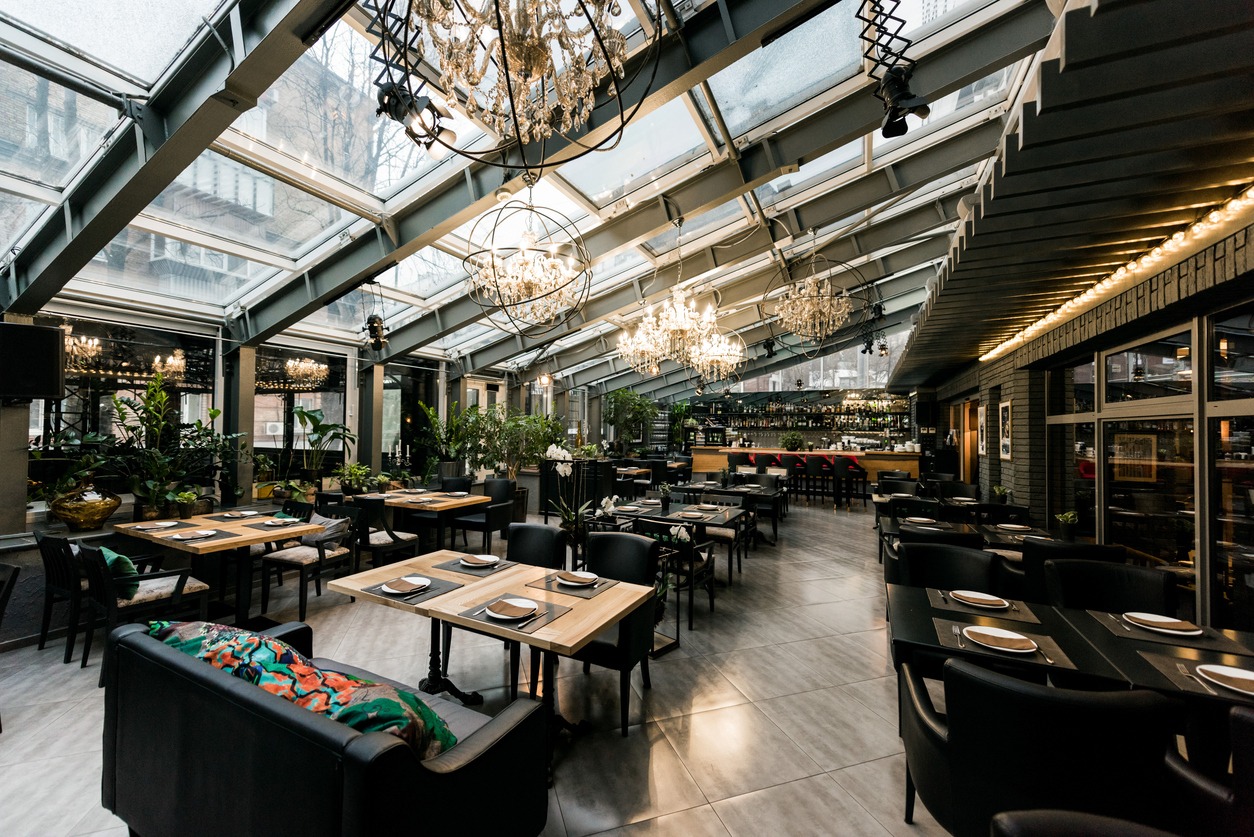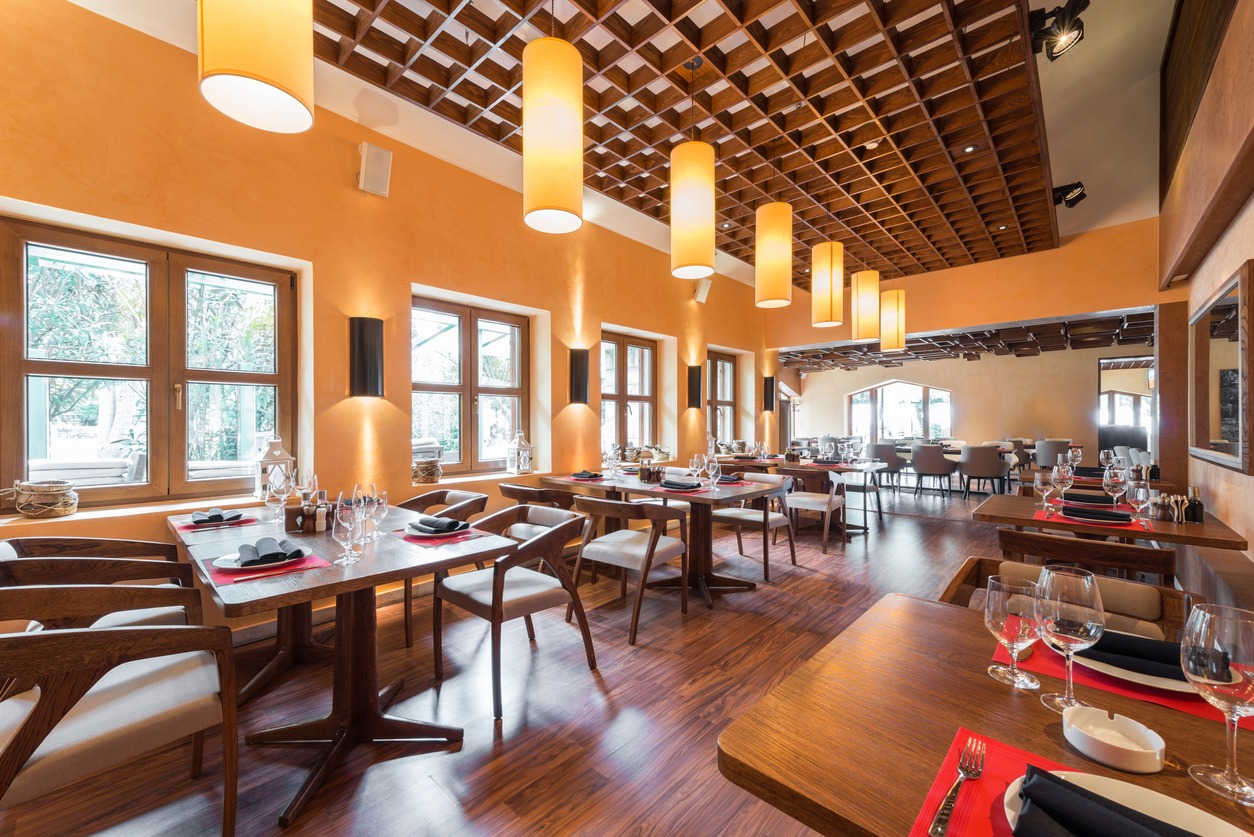If you are painting a new restaurant or repainting an existing one, have you decided on the interior colors to set the perfect ambiance for your guests?
Choosing the right colors and design for your restaurant’s interior can significantly impact your customers’ dining experience, influencing everything from their mood to how long they stay. Bold, warm colors can create an energetic atmosphere, while softer hues offer a more relaxed, intimate vibe. Partnering with a professional commercial painting company ensures you will achieve the best results with high-quality finishes designed to last so your restaurant always looks its best.
Why interior painting matters in a restaurant setting
First impressions
Interior paint is crucial in a restaurant setting because it shapes the guest experience from the moment they enter. The colors and quality of the walls set an immediate tone, whether it’s a warm, inviting ambiance for casual dining or a sleek, sophisticated feel for upscale settings. Guests often judge a space by its appearance, and well-chosen colors combined with quality finishes can create a memorable first impression that aligns with the restaurant’s vibe.
Influence on appetite and mood
Color also influences significantly appetite and mood. Warm colors like red, orange, and yellow can stimulate appetite and create a sense of comfort, making guests feel more relaxed and inclined to enjoy their meals. Cooler colors or subdued tones, on the other hand, are often used in fine dining to encourage calm and prolonged dining experiences.
Differentiation and branding
Furthermore, interior paint is a powerful tool for differentiation and branding. A restaurant’s color scheme can reflect its brand identity—such as vibrant, bold colors for a playful brand or elegant, muted tones for a more refined brand—making the space memorable and helping it stand out in a competitive market.
Factors to consider before painting

Here are the key factors to consider before painting, especially in restaurant and food-service environments:
- Type of paint: Durable, easy-to-clean paints are essential for high-traffic and food-handling areas. Choosing washable and scuff-resistant paints ensures that walls can withstand frequent cleaning without showing signs of wear, making them ideal for busy, high-contact zones.
- Lighting: Both natural and artificial lighting significantly impact how colors appear. Brighter lights usually enhance bold colors, while dim lighting can soften them. Evaluating the type and amount of lighting helps ensure colors appear as intended, aligning with the desired ambiance.
- Theme and style: The restaurant’s theme dictates color choices. For instance, a modern, minimalist space might use sleek neutrals or monochromatic tones, while a rustic theme could incorporate earth tones. Colors should support the brand’s aesthetic, whether it’s upscale, casual, or themed.
- Safety and compliance: Regulations often restrict certain paint types and finishes in food prep areas to ensure safety and hygiene. For instance, in kitchens, non-toxic, heat-resistant, and low-VOC paints may be required to avoid contamination or potential health risks, ensuring the space remains safe and compliant.
Choosing the right colors for a restaurant’s interior
Selecting the appropriate colors for a restaurant interior is vital for creating an ambiance that complements the dining experience and aligns with the restaurant’s concept.
Color psychology and effects
1. Warm colors (reds, oranges, yellows): These hues stimulate the appetite and create a vibrant, energetic atmosphere, making them ideal for fast-casual or family-style restaurants. Bold reds and oranges evoke warmth and excitement, encouraging a quicker dining pace, while yellows add a cheerful touch that invites sociability.
2. Cool colors (greens, blues): Cooler tones, like greens and blues, offer a relaxing ambiance, perfect for fine dining or health-conscious restaurants. Greens can reflect freshness and a connection to nature, while blue tones promote calmness and longer stays, suiting upscale or mindful dining environments.
3. Neutrals and accents: A neutral base, such as beige, gray, or taupe, serves as a sophisticated backdrop, allowing accent colors to add personality without overwhelming the space. Strategic accent colors, like bold jewel tones or soft pastels, can create focal points or complement the restaurant’s branding.
4. Room-specific color choices:
- Dining rooms: Warmer tones stimulate appetite, while neutral bases maintain a calm environment.
- Bars: Darker tones like deep reds or navy can enhance intimacy, while pops of metallics or neon create visual excitement.
- Kitchens: Bright whites and stainless-steel accents promote cleanliness and professionalism.
- Bathrooms: Neutral tones with subtle accents or soft lighting offer a serene, polished feel.
The painting process
Preparation and planning
Thorough preparation is key to a smooth painting process. This involves moving furniture, taping edges, and covering surfaces like floors, windows, and fixtures to prevent accidental paint splatters. A well-prepared space minimizes disruptions, thus ensuring that the restaurant’s cleanliness and organization are maintained throughout the project.
Scheduling to avoid downtime
To reduce the impact on daily operations, a professional painting company can schedule work during off-peak hours, such as overnight or early morning, when the restaurant is closed. Using quick-drying or low-odor paints helps ensure that areas can be reopened for use quickly, minimizing any negative effect on business flow.
Special techniques
Techniques like accent walls, texturing, or incorporating murals are popular choices to give the restaurant a unique, customized look. Accent walls can draw focus, while textures add depth, and murals bring personality. These creative approaches make the restaurant visually memorable, enhancing the overall dining atmosphere.
Maintenance and repainting tips

Cleaning and upkeep
Regular but gentle cleaning keeps freshly painted walls looking pristine. Use a soft cloth or sponge with mild soap and water to wipe down walls every few months, especially in high-traffic areas. For tougher stains, use non-abrasive cleaners—ideally, pH-neutral or specially formulated for painted surfaces. Avoid harsh chemicals, as these can degrade paint over time. For regular dusting, a soft microfiber cloth will help prevent buildup without scratching.
Knowing when to repaint
Signs that it’s time for a repaint include fading or yellowing of colors (often caused by sunlight), visible scuff marks or stains that no longer come off, peeling or chipping paint, and a generally dull appearance. In high-traffic areas or spaces exposed to sunlight, repainting may be necessary every 3–5 years. Regular touch-ups can also help maintain a fresh look in between full repaints, especially for areas prone to wear and tear.
Conclusion
Selecting the right colors and using quality paint can truly transform a restaurant’s ambiance, creating a welcoming atmosphere that enhances the overall guest experience.
Do you want more tailored guidance on color selection and professional painting services that meet unique needs for restaurant spaces? Contact Custom Painting, Inc., for a consultation! Call us at 925-294-8062 or message us on our contact page, and let us help bring your vision to life.

